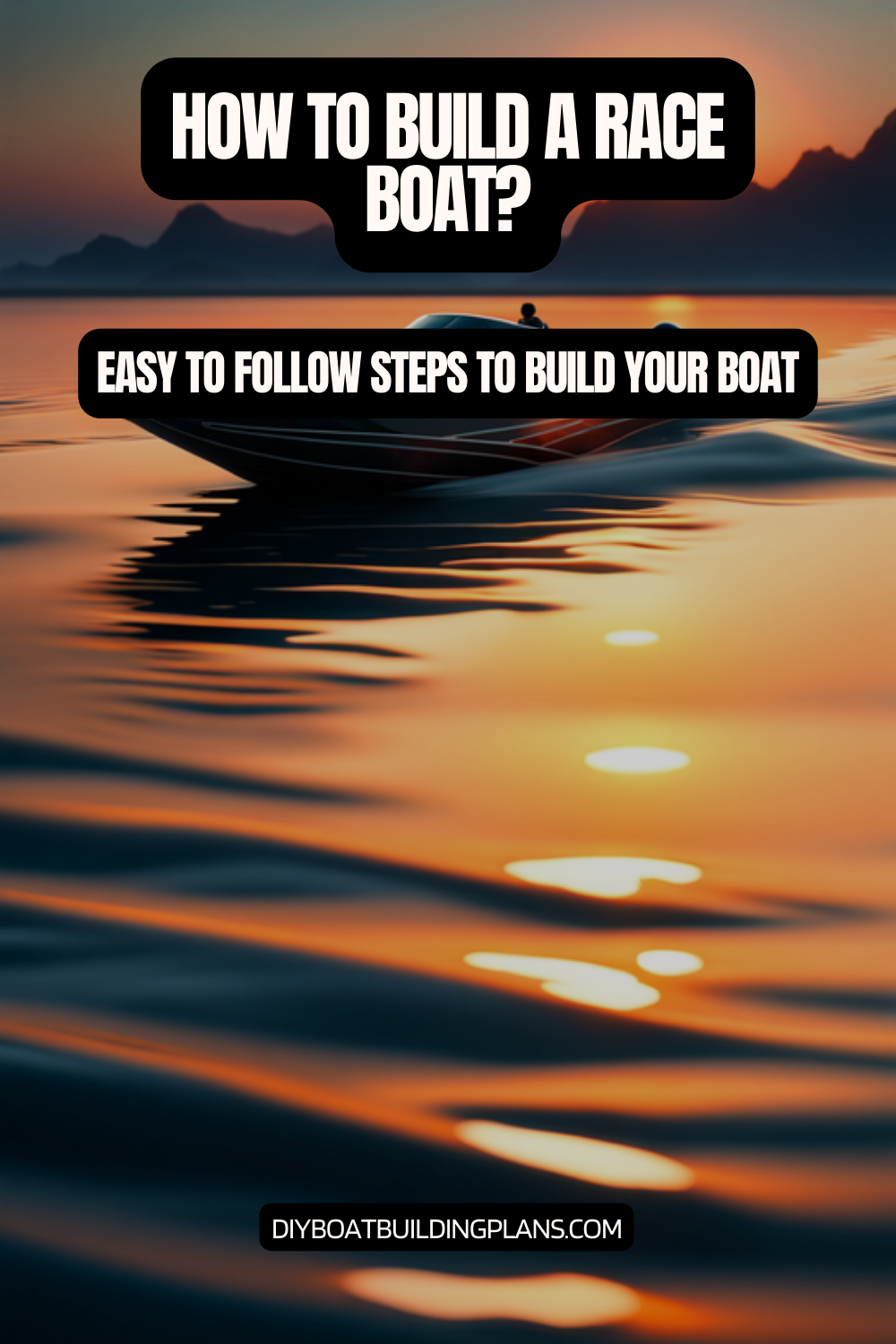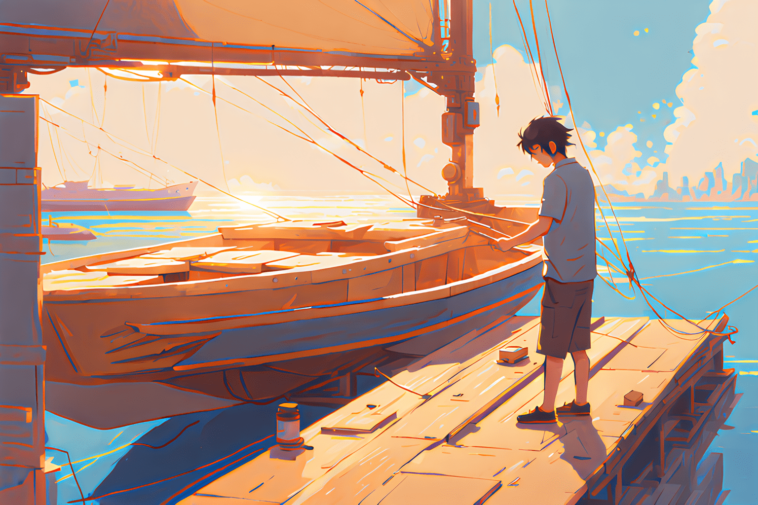Overview of How To Build a Race Boat
Designing a race boat is a complex and intricate process that requires a deep understanding of various design principles and factors. The choice of the right design can make a significant difference in the boat’s performance, handling, and overall efficiency. When it comes to selecting the optimal design for your race boat, it’s essential to consider several key elements.
First and foremost, it’s crucial to understand the different types of race boat designs available. From sleek and streamlined hulls to more aggressive and powerful designs, each option has its own unique characteristics and performance attributes. By familiarizing yourself with the various design options, you can better evaluate which one aligns with your specific needs and goals.
Another crucial factor to consider when selecting the design is the intended use of the race boat. Are you looking for a boat that excels in flat-water racing, or do you need a design that can handle rougher conditions? The design should be tailored to the specific demands of the racing environment, ensuring that the boat can perform at its best.
Researching and evaluating design options is a crucial step in the process. Consulting with experienced boat designers or builders can provide invaluable insights and guidance. These experts can help you analyze the pros and cons of different designs, taking into account factors such as hydrodynamics, stability, and maneuverability. By collaborating with these professionals, you can make an informed decision that aligns with your performance goals and budget.
Key Takeaways
- Choose a race boat design that suits your needs and preferences.
- Select high-quality materials that are appropriate for your boat’s intended use.
- Construct a strong and durable hull that can withstand the rigors of racing.
- Install a reliable and efficient propulsion system that can deliver maximum speed and power.
- Optimize your boat’s steering and controls to ensure precise handling and maneuverability.

Selecting the Appropriate Materials
The choice of materials used in the construction of a race boat is a critical factor that can significantly impact its performance, durability, and overall cost-effectiveness. When it comes to selecting the appropriate materials, it’s essential to explore the various options available and evaluate their respective properties and characteristics.
One of the primary considerations when selecting materials for a race boat is the balance between weight, strength, and durability. Lightweight materials, such as carbon fiber or advanced composites, can provide exceptional strength-to-weight ratios, allowing for a more agile and responsive boat. However, these materials can also be more expensive, so it’s important to weigh the trade-offs between performance and cost.
On the other hand, traditional materials like wood or aluminum may offer a more cost-effective solution, but they may not possess the same level of strength or weight-saving capabilities. Evaluating the performance characteristics of each material, such as their resistance to corrosion, impact, and weathering, is crucial in determining the best fit for your race boat.
Consulting with experienced boat builders or material experts can provide valuable insights into the selection process. These professionals can help you understand the nuances of different materials, their suitability for specific racing conditions, and the potential challenges or maintenance requirements associated with each option. By considering their recommendations and expertise, you can make an informed decision that balances performance, durability, and cost-effectiveness.
Constructing the Hull
The hull of a race boat is the foundation upon which the entire vessel is built, and its construction is a critical aspect of the boat-building process. Ensuring that the hull is properly designed, shaped, and assembled is essential for achieving optimal performance and stability on the water.
The first step in constructing the hull is to lay out the design and prepare the necessary templates or molds. This process involves carefully measuring and mapping out the desired shape and dimensions of the hull, taking into account factors such as buoyancy, hydrodynamics, and weight distribution. Precision is key at this stage, as any inaccuracies can have a significant impact on the boat’s overall performance.
Once the design is finalized, the next step is to cut and shape the hull components with meticulous attention to detail. This may involve the use of specialized tools and techniques, such as computer-aided design (CAD) software, CNC machining, or traditional hand-shaping methods. The goal is to ensure that each component fits together seamlessly, creating a strong and cohesive hull structure.
The assembly of the hull is a critical phase that requires the use of appropriate techniques and adhesives. Proper bonding and reinforcement of the hull components are essential to ensure the structural integrity of the boat. This may involve the use of epoxy resins, fiberglass, or other specialized materials, depending on the design and construction methods employed.
Throughout the construction process, it’s crucial to maintain a focus on balance and reinforcement. The hull must be designed and built to withstand the stresses and forces it will encounter during racing, ensuring that the boat remains stable, responsive, and capable of delivering optimal performance.
Installing the Propulsion System
The propulsion system is the heart of a race boat, responsible for providing the power and thrust necessary to achieve high speeds and competitive performance. Selecting the right engine or motor, and integrating it seamlessly with the boat’s design, is a crucial step in the construction process.
When it comes to choosing the propulsion system, a range of options are available, from traditional internal combustion engines to more advanced electric or hybrid systems. Each option has its own unique characteristics, such as power output, fuel efficiency, and environmental impact, and the selection should be based on the specific requirements of the race boat and the racing environment.
Once the propulsion system has been selected, the next step is to integrate it with the hull design. This involves ensuring proper alignment and installation of the engine or motor, as well as the integration of the fuel system, electrical components, and other necessary accessories. Careful attention to detail is crucial at this stage, as any misalignment or improper installation can have a significant impact on the boat’s performance and handling.
Throughout the installation process, it’s essential to work closely with experienced technicians or engineers who have a deep understanding of race boat propulsion systems. These professionals can provide valuable guidance and expertise, helping to ensure that the propulsion system is optimized for the specific design and performance requirements of the race boat.
By selecting the appropriate propulsion system and integrating it seamlessly with the boat’s design, you can unlock the full potential of your race boat, enabling it to achieve the speed, power, and responsiveness necessary to compete at the highest levels of the sport.
Optimizing the Steering and Controls
| Step | Description |
|---|---|
| 1 | Design the boat |
| 2 | Select the materials |
| 3 | Build the hull |
| 4 | Install the engine and propulsion system |
| 5 | Install the steering and control systems |
| 6 | Install the electrical and plumbing systems |
| 7 | Test the boat on water |
| 8 | Make any necessary adjustments |
| 9 | Finish the boat with paint and graphics |
The steering and control systems of a race boat are critical components that directly impact the driver’s ability to maneuver the vessel with precision and responsiveness. Designing and installing these systems with the utmost care and attention to detail is essential for achieving optimal performance on the water.
When it comes to the steering mechanism, the goal is to create a system that provides the driver with responsive and intuitive control over the boat’s direction. This may involve the use of advanced steering technologies, such as hydraulic or electronic systems, that offer enhanced precision and responsiveness. Careful consideration must be given to the integration of the steering system with the overall hull design, ensuring that the boat’s handling characteristics are optimized for the specific racing environment.
In addition to the steering mechanism, the race boat’s control systems, such as throttle, trim, and other adjustable features, play a crucial role in the driver’s ability to fine-tune the boat’s performance. These controls should be designed with the driver’s comfort and control in mind, allowing for easy access and intuitive operation during the heat of the race.
Integrating the steering and control systems with the boat’s overall design is a complex process that requires a deep understanding of both the technical aspects and the practical considerations of race boat operation. Consulting with experienced designers, engineers, or professional racers can provide valuable insights and guidance, helping to ensure that the steering and control systems are optimized for the specific needs and performance requirements of the race boat.
Through a combination of careful design, precise installation, and continuous testing and refinement, the steering and control systems can be transformed into a seamless extension of the driver’s own skills and intuition, enabling the race boat to perform at its absolute best.
Ensuring Structural Integrity
The structural integrity of a race boat is of paramount importance, as the vessel will be subjected to a wide range of stresses and forces during high-speed racing. Ensuring that the boat’s construction is robust and capable of withstanding these challenges is a critical aspect of the design and build process.
Reinforcing the hull and other critical components is a crucial step in maintaining the structural integrity of the race boat. This may involve the use of specialized materials, such as carbon fiber or advanced composites, that offer exceptional strength-to-weight ratios. Additionally, the incorporation of strategic bracing, bulkheads, and other structural elements can help to distribute the stresses and forces more evenly throughout the boat’s frame.
Careful consideration must be given to the specific stresses and forces that the race boat will encounter during its operation. This includes factors such as the boat’s speed, the conditions of the racing environment (e.g., waves, currents, wind), and the potential for impacts or collisions. By anticipating and addressing these challenges through the design and construction process, the race boat can be built to withstand the rigors of high-performance racing.
Verifying the overall structural integrity of the race boat is a critical final step in the construction process. This may involve extensive testing and inspection, including the use of specialized equipment and techniques to assess the strength, durability, and resilience of the boat’s construction. By ensuring that the race boat meets or exceeds the necessary structural standards, you can have confidence in its ability to perform at the highest levels of competition.
By prioritizing structural integrity throughout the design and build process, you can create a race boat that not only delivers exceptional performance but also provides the safety and reliability necessary for successful and competitive racing.
Enhancing Aerodynamics and Hydrodynamics
The performance of a race boat is heavily influenced by its aerodynamic and hydrodynamic properties, which determine how efficiently the vessel moves through the air and water. Optimizing these characteristics is a crucial aspect of the design and construction process, as it can unlock significant improvements in speed, efficiency, and overall competitiveness.
Analyzing the boat’s shape and design is the first step in enhancing its aerodynamic and hydrodynamic properties. This involves carefully studying the flow of air and water around the vessel, identifying areas of high drag or turbulence, and exploring ways to streamline the design for improved performance.
Incorporating features that reduce drag and improve efficiency is a key focus in this process. This may include the use of specialized hull shapes, foils, or other hydrodynamic elements that minimize resistance and maximize the boat’s ability to slice through the water. Similarly, attention must be paid to the design of the superstructure and other above-water components, ensuring that they are optimized for aerodynamic efficiency.
Experimentation and continuous refinement are essential in achieving the best possible aerodynamic and hydrodynamic performance. This may involve the use of computational fluid dynamics (CFD) software, wind tunnel testing, or on-water trials to evaluate the effectiveness of different design elements. By collaborating with experienced engineers, designers, or professional racers, you can leverage their expertise to identify and implement the most effective solutions.
By prioritizing the optimization of aerodynamics and hydrodynamics throughout the design and construction process, you can create a race boat that not only looks sleek and streamlined but also delivers unparalleled performance on the water. This attention to detail can be the difference between a competitive boat and a championship-winning vessel.
Finishing Touches and Customization
The final stages of race boat construction involve the application of finishing touches and customization, transforming the vessel from a functional piece of engineering into a true work of art and personal expression.
Applying the final coats of paint or other protective finishes is a critical step in ensuring the long-term durability and aesthetic appeal of the race boat. This process requires meticulous attention to detail, as the finish must not only be visually stunning but also capable of withstanding the harsh conditions of the racing environment.
In addition to the exterior finish, the installation of specialized equipment, such as instrumentation, safety gear, and other customized features, can further enhance the race boat’s capabilities and personalize the overall experience for the driver and crew.
Personalizing the race boat with unique design elements or graphics is another way to showcase the owner’s individual style and brand identity. This can include the incorporation of custom logos, color schemes, or other distinctive features that set the boat apart from the competition.
Throughout the finishing and customization process, it’s essential to maintain a focus on the overall aesthetic and branding of the race boat. The final product should not only perform at the highest levels but also reflect the owner’s vision and personality, creating a truly unique and memorable racing experience.
By meticulously attending to the finishing touches and customization of the race boat, you can elevate the vessel beyond a mere tool for competition and transform it into a true expression of your passion, skill, and personal style.
Testing and Refining the Race Boat
The final and perhaps most critical stage of the race boat construction process is the testing and refinement phase. This is where the boat’s performance is put to the test, and any necessary adjustments or improvements are identified and implemented to ensure the vessel is operating at its absolute best.
Conducting thorough testing and evaluation of the race boat’s performance is the first step in this process. This may involve a range of on-water trials, including speed tests, maneuverability assessments, and simulated racing conditions. By carefully monitoring the boat’s behavior and collecting detailed data, you can gain valuable insights into its strengths, weaknesses, and areas for improvement.
Identifying areas for improvement and implementing necessary adjustments is a crucial part of the refinement process. This may involve modifications to the hull design, propulsion system, steering and control mechanisms, or other key components. By addressing these issues proactively, you can ensure that the race boat is operating at peak efficiency and delivering the performance required to compete at the highest levels.
Collaborating with experienced racers or engineers can provide invaluable insights and guidance during the testing and refinement phase. These experts can offer their expertise in areas such as race strategy, boat handling, and technical analysis, helping to identify and resolve any issues that may arise.
Continuous refinement of the design and construction is the hallmark of a truly exceptional race boat. By constantly evaluating the boat’s performance, identifying areas for improvement, and implementing the necessary changes, you can ensure that the vessel is always operating at the cutting edge of racing technology and capability.
Through this rigorous process of testing, analysis, and refinement, the race boat can be transformed into a true champion, capable of delivering unparalleled performance and competitive success on the water.
Download over 500 Boat Plans. Click on the link below.
-->Click Here<--

Conclusion – How To Build a Race Boat
Building a race boat is a challenging and rewarding project that requires research, planning, design, construction, and testing. By following the steps and tips in this article, you can create your own race boat from scratch, and customize it to your preferences and specifications. You can also learn about boat building, engineering, and design principles, and enjoy the thrill and satisfaction of racing your own boat.
Whether you want to compete in a specific racing class, or just have fun on the water, building a race boat is a great way to express your creativity and passion. We hope this article has inspired and helped you to start your race boat building journey. If you have any questions or feedback, please feel free to contact us or leave a comment below.
FAQs – How To Build a Race Boat
What is a race boat?
A race boat is a type of watercraft designed and built for speed and agility in competitive racing events.
What materials are commonly used to build race boats?
Fiberglass, carbon fiber, Kevlar, and aluminum are commonly used materials to build race boats.
What are the basic steps to build a race boat?
The basic steps to build a race boat include designing the boat, selecting materials, building the hull, installing the engine and propulsion system, and adding finishing touches.
What factors should be considered when designing a race boat?
Factors such as the type of racing, water conditions, speed, and maneuverability should be considered when designing a race boat.
What is the importance of weight distribution in a race boat?
Weight distribution is important in a race boat as it affects the boat’s stability, speed, and maneuverability.
What type of engine is commonly used in race boats?
High-performance engines such as V8, V10, and V12 engines are commonly used in race boats.
What safety measures should be taken when building and operating a race boat?
Safety measures such as wearing life jackets, installing safety equipment such as fire extinguishers and bilge pumps, and following boating regulations should be taken when building and operating a race boat.



